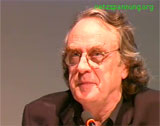


| URL: | http://netzspannung.org/database/89461/de |
| Last update: | 22.05.2003 |
| Date of print: |
 |
Benjamin H. D. Buchloh |
Kurzdarstellung
Kurzbeschreibung
This lecture will explore the precarious coexistence of a variety of figurative representational conventions in the work of Gerhard Richter. Beginning with his education as a Socialist Realist Mural painter in Dresden and culminating in the radical abnegation and reversal of the terms of his artistic production after his arrival in the West in 1961.
The paper will attempt to clarify how various models of anti-modernist returns to representation (Neo-Classicist and Realist) formed the general background of Richter's history: the initial presence of New Objectivity, the Fascist enforcement of a particularly insiduous type of Neo-Classicism, the Socialist fusion and variation of both legacies after 1948 in the DDR at the Academy in Dresden where Richter received his first education and the eventual adaptation to the photographic modes of representation under the impact of American Pop Art.
This attempt at an archaeology of painterly practices could explain Richter's apparently enigmatic commitment to a project of painterly discontinuity and rupture.
KünstlerInnen / AutorInnen
- Benjamin H. D. Buchloh, Professor für Kunstgeschichte, Barnard College der Columbia University, New York › Biografie
[link 02]
Termin
- 18. Mai 2002
Veranstalter
Getty Research Institute, Los Angeles und Haus der Kulturen der Welt, Berlin.
Veranstaltungsort
Haus der Kulturen der Welt, John-Foster-Dulles-Allee 10, 10557 Berlin, Deutschland
Eingabe des Beitrags
, 22.05.2003
Kategorie
- Vortrag
Schlagworte
Ergänzungen zur Schlagwortliste
- Gerhard Richter |
- Bildproduzenten |
- Realismus |
- Bildproduktion
|
|
| » http://www.hkw.de/de…fviewing/c_texte.html |
|
|